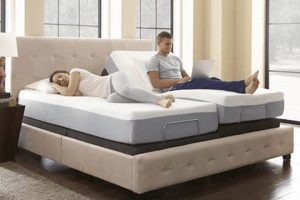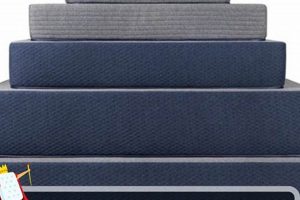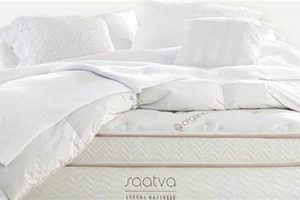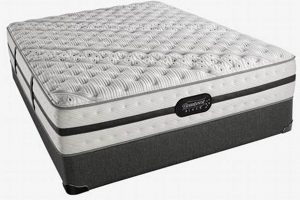The optimal sleep surface for elderly individuals experiencing joint inflammation aims to alleviate pressure points, promote proper spinal alignment, and facilitate ease of movement. For example, a mattress constructed with materials that conform to the body’s contours while providing adequate support can contribute to a more restful and pain-free sleep experience.
The selection of a suitable sleep environment is crucial for maintaining quality of life among seniors suffering from arthritis. A well-chosen mattress can significantly reduce nighttime discomfort, leading to improved sleep duration and overall physical well-being. Historically, advancements in material science and mattress design have focused on addressing the specific needs of individuals with musculoskeletal conditions, resulting in a wider array of specialized sleep products.
The following sections will delve into the key considerations when selecting a mattress designed to mitigate the effects of arthritis. This includes examining different mattress types, firmness levels, and material compositions, as well as exploring relevant features that can enhance comfort and accessibility for elderly individuals.
Guidance on Mattress Selection
The subsequent recommendations serve to guide the selection process for a sleep surface that addresses the unique needs of older adults experiencing arthritic discomfort.
Tip 1: Prioritize Pressure Relief: Seek mattresses incorporating memory foam or latex, as these materials conform to the body’s shape, distributing weight evenly and minimizing pressure on sensitive joints. A pressure mapping test can provide visual evidence of pressure reduction.
Tip 2: Assess Firmness Level: A medium-firm mattress typically offers an optimal balance of support and cushioning for individuals with arthritis. While personal preference plays a role, excessively soft mattresses may lack adequate spinal support, while excessively firm mattresses can exacerbate pressure point pain.
Tip 3: Evaluate Edge Support: Strong edge support is crucial for facilitating easier ingress and egress from the bed. Reinforced edges prevent sagging and provide a stable surface for sitting or pushing off when getting in and out of bed.
Tip 4: Consider Mattress Height: Choose a mattress height that allows for comfortable foot placement on the floor when sitting on the edge of the bed. An adjustable bed frame can further optimize bed height for individual needs.
Tip 5: Explore Adjustable Bases: An adjustable base allows for customized positioning of the head and legs, which can alleviate pressure on arthritic joints and improve circulation. Zero-gravity positions can simulate weightlessness and reduce spinal compression.
Tip 6: Research Material Composition: Opt for mattresses made with hypoallergenic and breathable materials to minimize allergen exposure and regulate body temperature. Certifications such as CertiPUR-US ensure that the foam used is free from harmful chemicals.
Tip 7: Inquire About Trial Periods and Warranties: Take advantage of trial periods offered by mattress retailers to assess the suitability of the mattress in the home environment. A comprehensive warranty protects against manufacturing defects and premature sagging.
By adhering to these guidelines, individuals can make informed decisions regarding mattress selection, ultimately contributing to improved sleep quality and reduced arthritic pain.
The concluding section will summarize the key considerations discussed and offer additional resources for further research.
1. Pressure Point Relief
Pressure point relief is a foundational consideration when selecting a sleep surface for elderly individuals experiencing arthritis. The ability of a mattress to minimize pressure on joints directly impacts pain levels and sleep quality.
- Conforming Materials and Weight Distribution
Materials such as memory foam and latex possess viscoelastic properties that allow them to conform to the body’s contours. This conformity distributes weight more evenly across the mattress surface, thereby reducing concentrated pressure on specific joints, such as hips, shoulders, and knees. A mattress failing to conform effectively can exacerbate pain by creating localized pressure points.
- Impact on Circulation
Sustained pressure on joints can impede blood flow, leading to increased pain and discomfort. Mattresses that effectively relieve pressure allow for improved circulation, promoting healing and reducing inflammation. This is particularly important for individuals with arthritis, as restricted blood flow can worsen joint stiffness and pain.
- Influence on Sleep Quality
Pain stemming from pressure points frequently disrupts sleep patterns, leading to fragmented sleep and daytime fatigue. A mattress designed for pressure relief can minimize nighttime awakenings and promote more restful sleep. This is crucial for seniors, who often experience age-related changes in sleep architecture.
- Material Density and Support Core Considerations
While conforming materials are essential, the underlying support core of the mattress must provide adequate stability and prevent excessive sinking. A mattress that is too soft may not provide sufficient support, leading to spinal misalignment and increased pain. Conversely, a mattress that is too firm may not offer adequate pressure relief. The optimal balance involves a conforming top layer combined with a supportive base layer.
The effective integration of conforming materials and a supportive core is paramount in a mattress designed to alleviate arthritic pain. Prioritizing pressure point relief through thoughtful material selection and construction directly contributes to improved comfort, reduced pain, and enhanced sleep quality for elderly individuals.
2. Spinal Alignment Support
Maintaining proper spinal alignment during sleep is a critical factor in mitigating arthritic pain and promoting overall well-being in elderly individuals. A mattress that adequately supports the spine can reduce pressure on affected joints, minimize muscle strain, and contribute to improved sleep quality.
- Contour Conformity and Weight Distribution
A mattress designed to provide spinal alignment support should conform to the natural curves of the spine, distributing weight evenly and minimizing pressure on specific vertebral segments. Memory foam and latex materials are often used to achieve this effect, as they mold to the body’s shape, providing targeted support to the lumbar, thoracic, and cervical regions of the spine. The absence of adequate contour conformity can lea
d to spinal misalignment, exacerbating arthritic pain and stiffness. - Firmness Level and Spinal Curvature
The firmness level of a mattress significantly impacts spinal alignment. A mattress that is too soft may allow the spine to sink into an unnatural curve, while a mattress that is too firm may not provide adequate cushioning. A medium-firm mattress typically offers an optimal balance of support and cushioning for individuals with arthritis, maintaining the natural curvature of the spine without excessive pressure. The ideal firmness level can vary depending on individual body weight and sleeping position.
- Lumbar Support and Postural Stability
Adequate lumbar support is crucial for maintaining spinal alignment, particularly for individuals with lower back arthritis. A mattress with enhanced lumbar support can prevent the lower back from sagging, reducing strain on the spinal muscles and ligaments. This support can be achieved through zoned construction, with firmer materials strategically placed in the lumbar region. The resulting postural stability promotes relaxation and reduces the risk of nighttime pain.
- Impact on Neuromuscular Function
Spinal misalignment can impinge on nerve function, leading to radiating pain and muscle spasms. A mattress that promotes proper spinal alignment can alleviate pressure on nerves, improving neuromuscular function and reducing pain signals. This is particularly important for individuals with arthritis, as nerve compression can exacerbate existing joint pain. The resulting improvement in neuromuscular function contributes to enhanced mobility and reduced discomfort.
The effective provision of spinal alignment support is integral to the selection of a mattress that addresses the needs of seniors with arthritis. By promoting proper spinal curvature, distributing weight evenly, and minimizing nerve compression, a well-designed mattress can significantly reduce pain, improve sleep quality, and enhance overall well-being. Neglecting this aspect in mattress selection can perpetuate arthritic symptoms and diminish quality of life.
3. Ease of Movement
The ability to easily change position in bed, enter and exit the bed, and generally move without undue strain is a critical factor when evaluating a mattress for seniors with arthritis. Arthritic conditions often limit range of motion and induce pain with movement; therefore, a mattress designed to facilitate ease of movement can significantly impact comfort, independence, and safety. Difficulties getting in and out of bed increase the risk of falls, a major concern for the elderly. A mattress that requires excessive effort to reposition can exacerbate joint pain and disrupt sleep.
The height of the mattress is a primary determinant of ease of movement. A mattress that is too low necessitates excessive bending to get in or out of bed, while a mattress that is too high may require climbing or awkward maneuvering. The ideal mattress height allows the individual to sit comfortably on the edge of the bed with feet flat on the floor. Edge support is another vital characteristic. Reinforced edges prevent sagging and provide a stable surface for pushing off when rising. Mattress materials also play a role. A responsive surface, such as latex or a hybrid construction, allows for smoother transitions compared to a slow-moving memory foam that may impede movement. Furthermore, an adjustable bed frame can greatly enhance ease of movement by allowing the user to raise or lower the head and legs, reducing strain on arthritic joints.
In summary, ease of movement is an indispensable component of a suitable mattress for seniors with arthritis. Factors such as mattress height, edge support, material responsiveness, and the potential integration of an adjustable base collectively contribute to a sleep environment that minimizes physical strain and promotes independence. Neglecting ease of movement in mattress selection can significantly impair functionality and increase the risk of injury for elderly individuals with arthritic conditions, thereby undermining the goal of achieving restful and restorative sleep.
4. Temperature Regulation
Temperature regulation represents a crucial consideration in mattress selection for elderly individuals afflicted with arthritis. Maintaining a comfortable sleep temperature can significantly influence sleep quality and pain perception, directly impacting overall well-being.
- Material Breathability
Mattress materials exhibiting high breathability facilitate airflow, dissipating body heat and moisture. Natural fibers, such as cotton and wool, along with open-cell foam structures, promote air circulation, preventing heat buildup. Conversely, dense, non-breathable materials can trap heat, leading to discomfort and disrupted sleep. This effect is amplified in individuals with arthritis, where inflammation can already contribute to increased body temperature and discomfort.
- Moisture Management
The ability of a mattress to wick away moisture is essential for maintaining a dry and comfortable sleep environment. Accumulation of sweat can lead to skin irritation and discomfort, further exacerbating arthritis-related pain. Materials with moisture-wicking properties, such as certain types of performance fabrics, draw moisture away from the body, promoting evaporative cooling and reducing the risk of skin problems. Individuals who experience night sweats or live in humid climates benefit significantly from this feature.
- Temperature-Regulating Technologies
Advanced mattress technologies, such as phase-change materials (PCMs), actively regulate temperature by absorbing and releasing heat as needed. PCMs can maintain a consistent sleep surface temperature, preventing overheating and chilling. These technologies are particularly beneficial for individuals with arthritis, who may experience fluctuations in body temperature due to inflammation or medication side effects. The application of such technologies allows for a more stable and comfortable sleep experience.
- Impact on Inflammation and Pain
Elevated sleep temperature can contribute to inflammation and pain. Conversely, a cool sleep environment can help reduce inflammation and alleviate discomfort. A mattress that effectively regulates temperature can help maintain a consistent sleep temperature, minimizing fluctuations that may exacerbate arthritis symptoms. Studies suggest that optimal sleep temperature can improve sleep quality and reduce pain perception in individuals with chronic pain conditions.
The interplay between material breathability, moisture management, and temperature-regulating technologies directly affects the suitability of a mattress for seniors with arthritis. Selecting a mattress that prioritizes temperature regulation can contribute to improved sleep quality, reduced pain, and enhanced overall comfort, thereby improving their daily life
5. Edge Support Stability
Edge support stability is a significant factor in determining the suitability of a mattress for elderly
individuals experiencing arthritis. Reduced mobility, balance issues, and joint pain associated with arthritis necessitate a stable and reliable mattress edge to facilitate safe ingress and egress from the bed.
- Reduced Risk of Falls
A firm and supportive mattress edge minimizes the risk of falls, a major safety concern for seniors. A collapsing or sagging edge can cause instability when sitting on the side of the bed, increasing the likelihood of a fall. Robust edge support provides a secure platform for transitioning in and out of bed, enhancing safety and independence. This is especially pertinent for individuals with arthritis, whose mobility is often compromised.
- Enhanced Stability for Transfers
Transfers between the bed and other surfaces, such as a wheelchair or walker, require a stable base of support. A mattress with strong edge support provides a secure surface for performing these transfers, reducing the strain on arthritic joints and minimizing the risk of injury. The absence of adequate edge support can create an unstable transfer environment, increasing the effort required and potentially leading to falls or exacerbation of joint pain.
- Increased Usable Sleep Surface
Strong edge support maximizes the usable sleep surface of the mattress. Without adequate edge support, the perimeter of the mattress may become unusable due to sagging or instability. This reduces the available space for sleeping comfortably and can restrict movement during the night. A stable edge allows for full utilization of the mattress surface, promoting greater freedom of movement and improved sleep quality.
- Durability and Longevity
Mattresses with reinforced edge support tend to exhibit greater durability and longevity. The edge of a mattress is often subject to significant stress, particularly from individuals sitting on the side of the bed. Robust edge construction prevents premature sagging and breakdown of the mattress perimeter, extending the lifespan of the mattress and preserving its performance characteristics over time. This is a cost-effective advantage for seniors seeking a long-term solution for their sleep needs.
The interplay between reduced fall risk, enhanced transfer stability, increased usable sleep surface, and improved durability underscores the importance of edge support stability in a mattress designed for seniors with arthritis. Selecting a mattress that prioritizes robust edge support promotes safety, independence, and long-term comfort.
Frequently Asked Questions
The following section addresses common inquiries regarding the selection of a suitable mattress for elderly individuals experiencing arthritis. The information aims to provide clarity and guidance based on established knowledge of mattress properties and arthritic conditions.
Question 1: Is a firm mattress always preferable for arthritis?
A firm mattress is not universally ideal. While some individuals find support beneficial, excessive firmness can exacerbate pressure point pain. A medium-firm mattress often provides a balance between support and cushioning, but individual preferences and specific arthritic conditions should guide the decision.
Question 2: How does memory foam benefit arthritis sufferers?
Memory foam conforms to the body’s contours, distributing weight and minimizing pressure on sensitive joints. This property can alleviate pain and promote improved circulation. However, some memory foam mattresses retain heat, which may be a concern for some individuals.
Question 3: Are adjustable beds genuinely helpful, or are they a luxury?
Adjustable beds offer quantifiable benefits for individuals with arthritis. The ability to elevate the head and legs can reduce pressure on joints, improve circulation, and facilitate easier ingress and egress from the bed. While not a necessity, they provide demonstrable therapeutic advantages.
Question 4: What role does mattress height play in easing arthritis symptoms?
Mattress height influences the ease with which one can get into and out of bed. A mattress of appropriate height allows for comfortable foot placement on the floor when sitting on the edge, reducing strain on joints. An adjustable bed frame can further customize the height.
Question 5: Should latex mattresses be considered as a viable option?
Latex mattresses offer several advantages, including durability, responsiveness, and breathability. Natural latex can be hypoallergenic, and its conforming properties provide pressure relief. However, latex mattresses may be more expensive than other options.
Question 6: Are there specific mattress certifications to look for when purchasing?
Certifications such as CertiPUR-US indicate that the foam used in the mattress has been tested for harmful chemicals. This provides assurance of product safety. Additionally, certifications related to organic materials, such as GOLS for latex, can be considered.
The selection of a mattress for arthritis necessitates careful consideration of individual needs and preferences, as well as an understanding of the properties of different mattress materials and features.
The following section offers resources for further investigation and expert consultation.
Conclusion
The exploration of the best mattress for seniors with arthritis reveals a multifaceted decision-making process. Considerations extend beyond mere comfort to encompass critical factors such as pressure relief, spinal alignment support, ease of movement, temperature regulation, and edge support stability. The integration of these elements directly influences sleep quality, pain management, and overall safety for elderly individuals grappling with arthritic conditions. Informed selection necessitates a comprehensive understanding of material properties, mattress construction, and individual physical needs.
Ultimately, the choice of a mattress represents a significant investment in long-term health and well-being. It is imperative that prospective buyers engage in thorough research, consult with healthcare professionals if needed, and prioritize factors that contribute to a secure and restorative sleep environment. The potential for enhanced comfort and reduced pain underscores the importance of making an informed and deliberate decision.




![Top Rated Best Wyoming King Mattress [Review] Organic & Natural Mattress Buyer’s Guide: Non-Toxic Sleep Solutions Top Rated Best Wyoming King Mattress [Review] | Organic & Natural Mattress Buyer’s Guide: Non-Toxic Sleep Solutions](https://mattressworldpa.com/wp-content/uploads/2025/07/th-7657-300x200.jpg)


